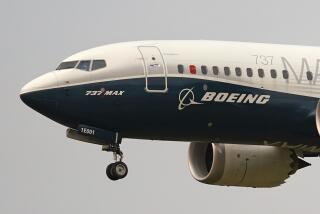Spirit Rover Turns Its Attention to Mars Roll-Off
- Share via
NASA’s Spirit rover severed its final connection to its lander and made the first of three turns that will line it up for its roll-off after 1 a.m. Thursday.
“It’s ready to rove,” flight director Chris Lewicki said Tuesday. All that’s left are two more turns scheduled for overnight Tuesday that will point the rover north-northwest for the roll-off.
Scientists at Pasadena’s Jet Propulsion Laboratory also released detailed photographs showing where the lander is sitting in Gusev Crater and where the rover will proceed on its mission to search for traces of water.
“We know where we are now and we know where we are going,” said principal investigator Steven Squyres of Cornell University.
Spirit’s first target will be a crater 200 yards wide about 800 feet to the northeast, although it is expected to make several stops along the way to examine individual rocks.
The crater “will provide a window into the subsurface of Mars,” Squyres said. “Once we have done our business there, we will have seen as deep into Mars as we can hope to see on this mission. Then, we will head for those hills” -- a cluster of hills to the east that is about 1.8 miles away.
Spirit is designed to travel about 600 yards during its planned 90-day life. But even if the rover dies on the way to the hills, it will glean a great deal of information, he added.
The team used two different techniques to determine the location of the rover, said JPL’s Joe Guinn, a member of the navigation team. In one, team members used the Mars Odyssey orbiter like a GPS satellite to triangulate the lander’s location to an area about 100 feet square.
In the second approach, a team led by JPL’s Tim Parker used stereo images from the rover’s panoramic camera to determine distances and directions to landmarks in the pictures. Plotting these on a photo made by the orbiters, they were able to locate the lander precisely.
The team was also provided new details about the craft’s landing on Jan. 3, information that showed that the computer on board the craft made several successful changes in the planned schedule of events.
The software opened the deployment parachute about 4.6 miles above the ground, a mile lower than the target altitude. attitude. “That makes things a little more exciting toward the ground,” said JPL’s Rob Manning, who heads the entry, descent and landing team.
But because the atmosphere was slightly denser than expected, the parachute slowed the craft’s descent more than anticipated, compensating for the lower opening. The retro rockets that slowed it further also fired lower than expected, at about 342 feet above the surface.






